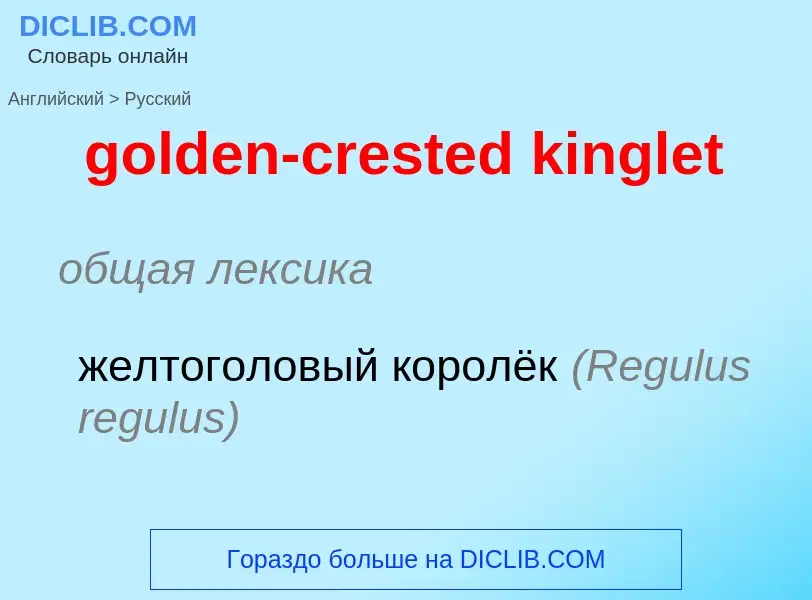Перевод и анализ слов искусственным интеллектом ChatGPT
На этой странице Вы можете получить подробный анализ слова или словосочетания, произведенный с помощью лучшей на сегодняшний день технологии искусственного интеллекта:
- как употребляется слово
- частота употребления
- используется оно чаще в устной или письменной речи
- варианты перевода слова
- примеры употребления (несколько фраз с переводом)
- этимология
golden-crested kinglet - перевод на русский
общая лексика
желтоголовый королёк (Regulus regulus)
['kiŋlit]
орнитология
королёк (Regulus)
Смотрите также
существительное
общая лексика
королек (птица)
презрительное выражение
царёк
царек
зоология
королёк (Regulus)
Определение
Википедия

The goldcrest (Regulus regulus) is a very small passerine bird in the kinglet family. Its colourful golden crest feathers, as well as being called the "king of the birds" in European folklore, gives rise to its English and scientific names. The scientific name, R. regulus, means king or knight. Several subspecies are recognised across the very large distribution range that includes much of the Palearctic and the islands of Macaronesia and Iceland. Birds from the north and east of its breeding range migrate to winter further south.
This kinglet has greenish upper-parts, whitish under-parts, and has two white wingbars. It has a plain face contrasting black irises and a bright head crest, orange and yellow in the male and yellow in the female, which is displayed during breeding. It superficially resembles the common firecrest (Regulus ignicapilla), which largely shares its European range, but the latter's bronze shoulders and strong face pattern are distinctive. The song is a repetition of high thin notes, slightly higher-pitched than those of its relative. Birds on the Canary Islands are now separated into two subspecies of the goldcrest, but were formerly considered to be a subspecies of the firecrest or a separate species, Regulus teneriffae.
The goldcrest breeds in coniferous woodland and gardens, building its compact, three-layered nest on a tree branch. Ten to twelve eggs are incubated by the female alone, and the chicks are fed by both parents; second broods are common. This kinglet is constantly on the move as it searches for insects to eat, and in winter it is often found with flocks of tits. It may be killed by birds of prey or carry parasites, but its large range and population mean that it is not considered to present any significant conservation concerns.


![John Moore]]. Fishermen in Suffolk referred to the goldcrest as the "herring spink". John Moore]]. Fishermen in Suffolk referred to the goldcrest as the "herring spink".](https://commons.wikimedia.org/wiki/Special:FilePath/Fishing boat by John Moore of Ipswich.jpg?width=200)
![The recently discovered subspecies ''R. r. ellenthalerae'' occurs in [[laurisilva]] forest on [[La Palma]] (above) and [[El Hierro]]. The recently discovered subspecies ''R. r. ellenthalerae'' occurs in [[laurisilva]] forest on [[La Palma]] (above) and [[El Hierro]].](https://commons.wikimedia.org/wiki/Special:FilePath/Forest Los Tilos.jpg?width=200)
![''R. r. sikkimensis'' from [[Pangolakha Wildlife Sanctuary]] in [[Sikkim]], [[India]]. ''R. r. sikkimensis'' from [[Pangolakha Wildlife Sanctuary]] in [[Sikkim]], [[India]].](https://commons.wikimedia.org/wiki/Special:FilePath/Goldcrest Pangolakha WLS Sikkim India 07112018.jpg?width=200)
![Subspecies ''R. r. himalayensis'' at Vinayak village in [[Uttarakhand]], [[India]] Subspecies ''R. r. himalayensis'' at Vinayak village in [[Uttarakhand]], [[India]]](https://commons.wikimedia.org/wiki/Special:FilePath/Goldcrest Vinayak Uttarakhand India 05.02.2015.jpg?width=200)




![Male in [[France]] displaying orange crest feathers that are set within a narrow rim of yellow feathers Male in [[France]] displaying orange crest feathers that are set within a narrow rim of yellow feathers](https://commons.wikimedia.org/wiki/Special:FilePath/Regulus regulus -Vendee, France-8.jpg?width=200)


!['' Regulus regulus regulus '' – [[MHNT]] '' Regulus regulus regulus '' – [[MHNT]]](https://commons.wikimedia.org/wiki/Special:FilePath/Regulus regulus regulus MHNT.ZOO.2010.11.207.jpg?width=200)
!['' Regulus regulus azoricus '' – [[MHNT]] '' Regulus regulus azoricus '' – [[MHNT]]](https://commons.wikimedia.org/wiki/Special:FilePath/Regulus regulus azoricus MHNT.ZOO.2010.11.207.jpg?width=200)
!['' Regulus regulus inermis '' – [[MHNT]] '' Regulus regulus inermis '' – [[MHNT]]](https://commons.wikimedia.org/wiki/Special:FilePath/Regulus regulus inermis MHNT.ZOO.2010.11.207.jpg?width=200)
!['' Regulus regulus teneriffae '' – [[MHNT]] '' Regulus regulus teneriffae '' – [[MHNT]]](https://commons.wikimedia.org/wiki/Special:FilePath/Regulus regulus teneriffae MHNT.ZOO.2010.11.jpg?width=200)
